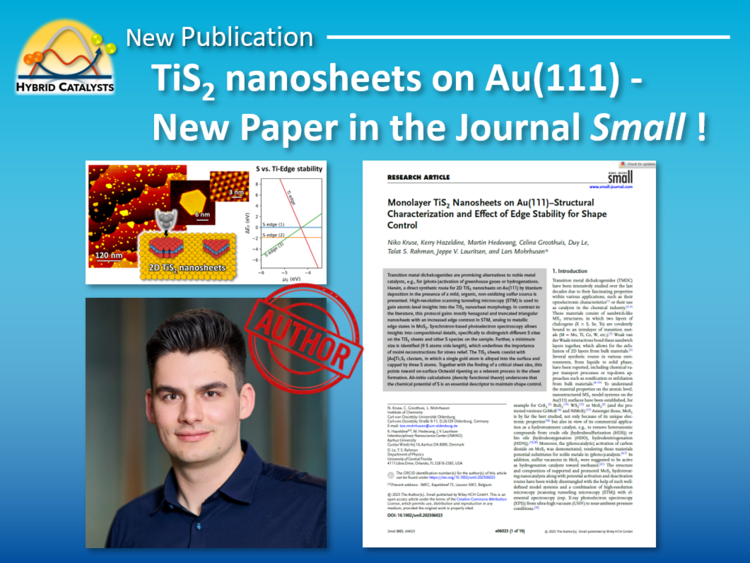Wir freuen uns, die Veröffentlichung eines neuen Artikels in Small bekannt zu geben: „Monolayer TiS2 Nanosheets on Au(111)–Structural Characterization and Effect of Edge Stability for Shape Control”, basierend auf der Arbeit von Niko Kruse.
Diese Studie präsentiert eine neuartige UHV-basierte Methode zur Synthese von einlagigen TiS₂-Nanoschichten auf der Au(111) Oberfläche, durch gemeinsame Abscheidung von Titan in Gegenwart einer milden organischen Schwefelquelle.
Unsere Arbeit erweitert die Familie der gut definierten 2D-Nanomaterialien um TiS₂, ein weniger häufig untersuchtes Übergangsmetall-Dichalkogenid, und wirft ein neues Licht auf seine Eigenschaften auf atomarer Ebene und seine Entstehungsmechanismen. Der Artikel zeigt, wie experimentelle Parameter verwendet werden können, um die Formverteilung von 2D-Nanomaterialien über die Kantenstabilität zu regulieren, was für die Katalyse und Photokatalyse von Bedeutung sein könnte.
Ein großes Dankeschön an unsere Co-Autoren Kerry Hazeldine, Martin Hedevang, Jeppe V. Lauritsen und Celina Groothuis für ihre Unterstützung bei der experimentellen Arbeit sowie an Duy Le und Talat Rahman für die wesentlichen theoretischen Untersuchungen. Großartige Zusammenarbeit!
Den Artikel finden Sie hier.
Abstract
Transition metal dichalcogenides are promising alternatives to noble metal catalysts, e.g., for (photo-)activation of greenhouse gases or hydrogenations. Herein, a direct synthetic route for 2D TiS2 nanosheets on Au(111) by titanium deposition in the presence of a mild, organic, non-oxidizing sulfur source is presented. High-resolution scanning tunneling microscopy (STM) is used to gain atomic-level insights into the TiS2 nanosheet morphology. In contrast to the literature, this protocol gains mostly hexagonal and truncated triangular nanosheets with an increased edge contrast in STM, analog to metallic edge states in MoS2. Synchrotron-based photoelectron spectroscopy allows insights into compositional details, specifically to distinguish different S sites on the TiS2 sheets and other S species on the sample. Further, a minimum size is identified (9 S atoms side length), which underlines the importance of moiré reconstructions for stress relief. The TiS2 sheets coexist with [Au]Ti1S3 clusters, in which a single gold atom is alloyed into the surface and capped by three S atoms. Together with the finding of a critical sheet size, this points toward on-surface Ostwald ripening as a relevant process in the sheet formation. Ab-initio calculations (density functional theory) underscore that the chemical potential of S is an essential descriptor to maintain shape control.


